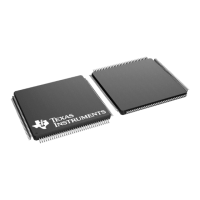CAN Blocks
www.ti.com
1420
SPNU563A–March 2018
Submit Documentation Feedback
Copyright © 2018, Texas Instruments Incorporated
Controller Area Network (DCAN) Module
27.2.4 Message RAM Interface
The Interface Register sets control the CPU read and write accesses to the Message RAM. There are
three interface registers IF1, IF2, and IF3:
• IF1 and IF2 Interface Registers sets for read and write access.
• IF3 Interface Register set for read access only.
The Interface Registers have the same word-length as the Message RAM. Additional information can be
found in Section 27.6.
27.2.5 Register and Message Object Access
During normal operation, data consistency of the message objects is guaranteed by indirectly accessing
the message objects through the interface registers IF1 and IF2.
In order to be able to perform tests on the message object memory, a dedicated test mode has been
implemented, that allows direct access by either the CPU or DMA. During normal operation direct access
has to be avoided.
27.2.6 Dual Clock Source
Two clock domains are provided to the DCAN module:
1. VCLK - The peripheral synchronous clock domain as the general module clock source.
2. VCLKA - The peripheral asynchronous clock source domain provided to the CAN core as clock source
(CAN_CLK) for generating the CAN Bit Timing.
If a frequency modulated clock output from FMPLL is used as the VCLK source, then VCLKA should be
derived from an unmodulated clock source (for example, OSCIN source).
The clock source for VCLKA is selected by the Peripheral Asynchronous Clock Source Register in the
system module.
Both clock domains can be derived from the same clock source (so that VCLK = VCLKA). However, if
frequency modulation in the FMPLL is enabled (spread spectrum clock), then due to the high precision
clocking requirements of the CAN Core, the FMPLL clock source should not be used for VCLKA.
Alternatively, a separate clock without any modulation (for example, derived directly from the OSCIN
clock) should be used for VCLKA.
Refer to the system module reference guide and the device datasheet for more information how to
configure the relevant clock source registers in the system module.
Between the two clock domains, a synchronization mechanism is implemented in the DCAN module in
order to ensure correct data transfer.
NOTE: If the dual clock functionality is used, then VCLK must always be higher or equal to
CAN_CLK (derived from the asynchronous clock source), in order to achieve a stable
functionality of the DCAN. Here also the frequency shift of the modulated VCLK has to be
considered:
ƒ
0, VCLK
± Δƒ
FM,VCLK
≥ ƒ
CANCLK
The CAN Core has to be programmed to at least 8 clock cycles per bit time. To achieve a
transfer rate of 1 MBaud when using the asynchronous clock domain as the clock source for
CAN_CLK, an oscillator frequency of 8MHz or higher has to be used.

